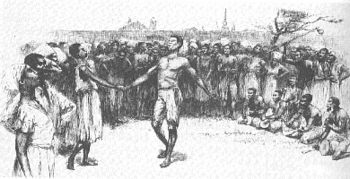Bamboula
| Percussion instrument | |
|---|---|
| Classification | Membranophone |
| Hornbostel–Sachs classification |
211.212.1 (Cylindrical drums) |

A bamboula is a type of drum made from a section of giant bamboo with skin stretched over the ends.[1] It is also a dance accompanied by music from these drums.
Etymology
The term is derived from kam-bumbulu and ba m'bula in the Bantu languages which means drum.
History

Originating in Africa, the bamboula form appears in a Haitian song in 1757 and bamboula became a dance syncopation performed to the rhythm of the drum during festivals and ceremonies in Haiti (then Saint-Domingue). It was then exported to the United States (notably Mobile, Alabama, and the Virgin Islands) through Louisiana, by the Africans that were deported to New Orleans[2][3][4] during the 18th century with the arrival of the displaced French settlers of the island of San Domingo especially after the Haitian Revolution. The slaves found themselves on the Congo Square to the edge of the area of the French Quarter of New Orleans to dance the bamboula.
In 1848, Louisiana, Louis Moreau Gottschalk was born in New Orleans but also a native of Saint-Domingue by his mother, who wrote the first swing, entitled The Bamboula.
References
- ↑ Valdman, Albert (1998). Dictionary of Louisiana Creole. Bloomington, Ind.: Indiana University Press. ISBN 978-0-253-33451-0.
- ↑ Society of Arts and Crafts (1919). Theatre Arts. New York: Theatre Publications, Inc.
- ↑ Federal Writers' Project, Writers' Program (1947). Louisiana: A Guide to the State. New York: Hastings House. pp. 98, 279.
- ↑ Courlander, Harold. A Treasury of Afro-American Folklore: The Oral Literature, Traditions, Recollections, Legends, Tales, Songs, Religious Beliefs, Customs, Sayings and Humor of Peoples of African American Descent in the Americas. Marlowe Company. pp. 94–95. ISBN 978-1-56924-501-9.
External links
- Bamboula Dance Drums (includes audio sample), Smithsonian Global Sound.
- Bamboula Dance, Sonny Watson's StreetSwing
- Morris, Ayesha (February 25, 2006). "The Power of Dance: Bamboula has deep and strong ties to African heritage, island history and freedom fight". The Virgin Islands Daily News. Retrieved 2009-05-20.